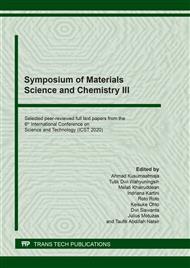[1]
R.C. Kuhad, R. Gupta, A. Singh, Microbial cellulases and their industrial applications, Enzyme Res. 2011 (2011) 280696.
Google Scholar
[2]
D.S. Chahal, Solid-state fermentation with Trichoderma reesei for cellulase production, Appl. Environ. Microbiol. 49 (1) (1985) 205-210.
DOI: 10.1128/aem.49.1.205-210.1985
Google Scholar
[3]
X-Z. Zhang, Y-H.P. Zhang, Cellulases: characteristics, sources, production, and applications, in: S-T. Yang, H.A. El-Enshasy, N. Thongcul (Eds.), Bioprocessing Technologies in Biorefinery for Sustainable Production of Fuels, Chemicals, and Polymers, John Wiley & Sons, Inc., New Jersey, 2013, pp.131-146.
DOI: 10.1002/9781118642047.ch8
Google Scholar
[4]
K. Muzakhar, Sutoyo, A.B. Saragih, Phosphate solubilizing bacteria adaptive to vinasse, J. Math. Fundam. Sci. 47 (2) (2015) 219-225.
DOI: 10.5614/j.math.fund.sci.2015.47.2.8
Google Scholar
[5]
M. Sohail, R. Siddiqi, A. Ahmad, S.A. Khan, Cellulase production from Aspergillus niger MS82: effect of temperature and pH, N. Biotechnol. 25 (6) (2009) 437-441.
DOI: 10.1016/j.nbt.2009.02.002
Google Scholar
[6]
S. Mrudula, R. Murugammal, Production of cellulase by Aspergillus niger under submerged and solid-state fermentation using coir waste as a substrate, Braz. J. Microbiol. 42 (2011) 1119-1127.
DOI: 10.1590/s1517-83822011000300033
Google Scholar
[7]
K. Muzakhar, A Consortium of Three Enzymes: xylanase, arabinofuranosidase, and cellulase from Aspergillus sp. which liquefied coffee pulp wastes, IOP Conf. Ser.: Mater. Sci. Eng. 546 (2) (2019) 022013.
DOI: 10.1088/1757-899x/546/2/022013
Google Scholar
[8]
W. Yuniar, Skrining dan identifikasi kapang selulolitik pada proses vermikomposting tandan kosong kelapa sawit, Undergraduate Thesis, Universitas Jember, Jember, (2013).
Google Scholar
[9]
A. Pandey, C.R. Soccol, D. Mitchell, New developments in solid state fermentation: I- bioprocesses and products, Process Biochem. 35 (10) (2000) 1153-1169.
DOI: 10.1016/s0032-9592(00)00152-7
Google Scholar
[10]
Information on http://www.ico.org.
Google Scholar
[11]
S. Roussos, M.de los A. Aquiáhuatl, M.del R. Trejo-Hernández, I.G. Perraud, E. Favela, M. Ramakrishna, M. Raimbault, G. Viniegra-González, Biotechnological management of coffee pulp - isolation, screening, characterization, selection of caffeine-degrading fungi and natural microflora present in coffee pulp and husk, Appl. Microbiol. Biotechnol. 42 (1995) 756-762.
DOI: 10.1007/bf00171958
Google Scholar
[12]
G. Corro, L. Paniagua, U. Pal, F. Bañuelos, M. Rosas, Generation of biogas from coffee- pulp and cow-dung co-digestion: Infrared studies of postcombustion emissions, Energy Convers. Manag. (2013) 471-481.
DOI: 10.1016/j.enconman.2013.07.017
Google Scholar
[13]
L.G.A. Ong, S. Abd-Aziz, S. Noraini, M.I.A. Karim, M.A. Hassan, Enzyme production and profile by Aspergillus niger during solid substrate fermentation using palm kernel cake as substrate, Appl. Biochem. Biotechnol. 118 (1-3) (2004) 73-79.
DOI: 10.1385/abab:118:1-3:073
Google Scholar
[14]
S. Ubaidillah, K. Muzakhar, Sugar-rich hydrolyzates from coffee pulp waste which produced under solid state fermentation by Pestalotiosis sp. VM9 and Aspergillus sp. VTM5, and its efficiency as medium for single cell protein Saccharomyces cerevisiae, IOP Conf. Ser.: Mater. Sci. Eng. 546 (6) (2019) 062033.
DOI: 10.1088/1757-899x/546/6/062033
Google Scholar
[15]
T.M. Wood, K.M. Bhat, Methods for measuring cellulase activities, Methods Enzymol. 160 (1988) 87-112.
Google Scholar
[16]
K. Selvam, M. Govarthanan, S.K. Kannan, M. Govindharaju, B. Senthilkumar, T. Selvankumar, A. Sengottaiyan, Process optimization of cellulase production from alkali-treated coffee pulp and pineapple waste using Acinetobacter sp. TSK-MASC, RSC Adv. 4 (25) (2014) 13045-13051.
DOI: 10.1039/c4ra00066h
Google Scholar
[17]
M. Narra, G. Dixit, J. Divecha, D. Madamwa, A.R. Shah, Production of cellulases by solid state fermentation with Aspergillus terreus and enzymatic hydrolysis of mild alkali-treated rice straw, Bioresour. Technol. 121 (2012) 355-361.
DOI: 10.1016/j.biortech.2012.05.140
Google Scholar
[18]
M. Raimbault, D.A. Alazard, Culture method to study fungal growth in solid fermentation, Eur. J. Appl. Microbiol. Biotechnol. 9 (1980) 199-209.
DOI: 10.1007/bf00504486
Google Scholar
[19]
F. Deschamps, C. Giuliano, M. Asther, M.C. Huet, S. Roussos, Cellulase production by Trichoderma harzianum in static and mixed solid-state fermentation reactors under nonaseptic conditions, Biotechnol. Bioeng. 27 (9) (1985) 1385-1388.
DOI: 10.1002/bit.260270917
Google Scholar
[20]
S.J.B. Duff, W.D. Murrayh, Bioconversion of forest products industry waste cellulosics of fuel ethanol : a review, Bioresour. Technol. 55 (1) (1996) 1-33.
DOI: 10.1016/0960-8524(95)00122-0
Google Scholar
[21]
N.M. Mubarak, J.R. Wong, K.W. Tan, J.N. Sahu, E.C. Abdullah, N.S. Jayakumar, P. Ganesan, Immobilization of cellulase enzyme on functionalized multiwall carbon nanotubes, J. Mol. Catal. B: Enzym. 107 (2014) 124-131.
DOI: 10.1016/j.molcatb.2014.06.002
Google Scholar
[22]
D. Liu, R. Zhang, X. Yang, H. Wu, D. Xu, Z. Tang, Q. Shen, Thermostable cellulase production of Aspergillus fumigatus Z5 under solid- state fermentation and its application in degradation of agricultural wastes, Int. Biodeterior. Biodegrad. 65 (5) (2011) 717-725.
DOI: 10.1016/j.ibiod.2011.04.005
Google Scholar
[23]
S.P. Gautam, P.S. Bundela, A.K. Pandey, J. Khan, M.K. Awasthi, S. Sarsaiya, Optimization for the production of cellulase enzyme from municipal solid waste residue by two novel cellulolytic fungi, Biotechnol. Res. Int. 2011 (2011) 810425.
DOI: 10.4061/2011/810425
Google Scholar


